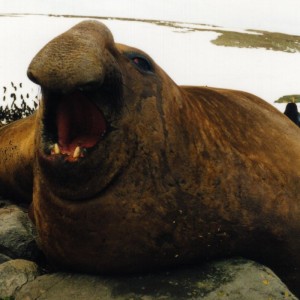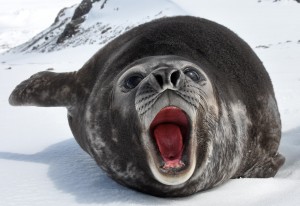The Southern Elephants is the biggest living Carnivoran. They are called Elephant Seals because they are so huge and they have trunk-like noses of the male. The trunk-like noses are used to make loud roaring noises.
The Southern Elephant Seal is bigger than the Northern Elephant Seal. It has a wider trunk-like nose. The Northern Elephant Seal is found in and around California. It lives mainly on islands off the coast. The Southern Elephant Seal live mainly around Antarctica.

The male Southern Elephant Seal is about 5 to 6 times larger than the female. The female will weigh about 400 to 900 kilograms (900 to 2000 lb) and is about 2.6 to 3 metres (8.5 to 10 feet) long. On the hand, the males weigh about 2200 to 4000 kilograms (5000 to 9000 lb) and it is about 4.2 to 5 metres (14 to 16 feet) long. Their pups weigh about 40 kilograms (90 lb) at birth and are normally drinks its mother’s milk for only about 3 weeks. Until then, the mother seal will not eat, so both mother and child are living off the energy stored in the mother’s thick layer of fat. After nearly a month of fasting, the mother loses quite a lot of weight!
Their eyes are big, round and black. These eyes are important in hunting. Their have hind limbs that are used as a tail fin. Each of the limbs has 5 long webbed fingers. The fins which are situated on each side are not used much while swimming. These fins are used instead to pull themselves along on land. They are able to move themselves quickly – as fast as 8 kilometres per hour (5 miles per hour) for short distances. Although they look clumsy when they are moving on land, their top speed makes them dangerous if they are disturbed.
The elephant seal does not need to spend a long time resting on the surface of the water. They only need a few minutes to breathe in enough air for the next long dive. They will dive repeatedly, each time for more than 20 minutes and up to 2 hours, hunting for prey like squid and fish. They are the deepest diving seal in the world. They are able to dive as deep as 400 meters (1300 feet).

Their body is shaped like a torpedo, which helps to make them great swimmers. What’s more, their bodies are able to store a lots of blood – good for carrying oxygen. They even have extra spaces in their body to store extra blood! All this helps them be champion divers – they can take a breath and hold it for such a long long time.
In the oceans, the seals live alone. Most female seals dive almost to the bottom of the sea. The male seals dive not only to the bottom of the sea, they dive to the bottom of the deepest parts of the sea! They will return each year to the same hunting area. Their main feeding area is at the edge of Antarctica. While hunting in the dark oceans, the light emitted by some prey animals helps the seals to capture them easily. The seals are sensitive to vibrations. Having this sensitivity also assists them in capturing their prey. Their main predator is the Killer Whale.
Elephant seals can stay on land for a long time. They can stay dry for several weeks each year. Male elephant seals will defend their territories. Sometimes there will be violent battles between the males but fortunately they rarely kill each other. While defending their territories, they will stay for months without eating, sometimes up to 3 months. They will just live on their energy stored in the body fat. The defeated male seal will flee after suffering severe tears and cuts.
Male Southern Elephant Seals will make noises like a coughing roar to let others know who they are and how big they are. Fights between males are often resolved with posturing to show who is the boss and roaring rather than striking each other with their trunks and teeth.
Baby seals which have stopped taking milk will gather together until they lose their fur they were born with. This furry black coat is not suitable for swimming but it keeps them warm in the cold. After they lose their birth coats, their fur may turn gey and brown, depending on the thickness and moisture of the hair. The older male seals will have skin which looks like thick leather which is often scarred after a seal battle.

Elephant seals were once hunted for their oil. They were very nearly wiped out in the 19th century. Fortunately, laws were passed to protect them and their breeding sites are protected, therefore these efforts have helped to make sure that the Southern Elephant Seals are not endangered any more.
Thank you SOOOO Much I have needed this information for a school project and this has given me heaps